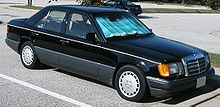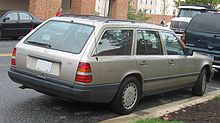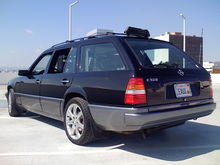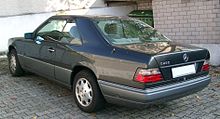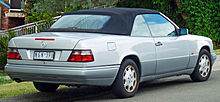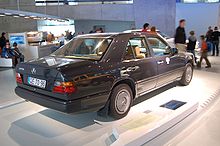- Mercedes-Benz W124
-
Mercedes-Benz W124 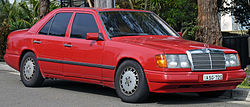
Manufacturer Mercedes-Benz (Daimler-Benz) Production 1984–1996 Assembly Bremen, Germany
Sindelfingen, Germany
Rastatt, Germany
Zuffenhausen, GermanyPredecessor Mercedes-Benz W123 Successor Mercedes-Benz W210 (sedan & estate)
Mercedes-Benz W208 (coupe & convertible)Class Mid-size, executive car Body style 4-door sedan
4-door station wagon
2-door coupe
2-door convertibleLayout Front engine, rear-wheel drive / four-wheel drive Engine Petrol
I4
2.0 L M102
2.0 L M111
2.2 L M111
2.3 L M102
I6
2.6 L M103
2.8 L M104
3.0 L M103
3.0 L M104
3.2 L M104
3.4 L M104
3.6 L M104
V8
4.2 L M119
5.0 L M119Diesel
3.0 L OM603
I4
2.0 L OM601
I5
2.5 L OM602
2.5 L OM605
I6
3.0 L OM606Transmission Automatic
4-speed
5-speed
Manual
4-speed
5-speedW124 is the Mercedes-Benz internal chassis-designation for the 1985 to 1995 version of the Mercedes-Benz E-Class. The W124 models replaced the W123 models after 1985 and were superseded by the W210 E-Class after 1995.
Contents
History
The W124 is a mid-sized vehicle platform. Due to the high cost of German engineering and build quality, the W124 was designed to last many miles, with awards actually given and worn by high mileage versions.
Front suspension uses a separate spring and damper with a rubber top mount. The rear suspension of the W124 features the Mercedes multi-link axle introduced in 1982 with the Mercedes 190 and which is now standard on many modern cars. Estate cars (and optionally, saloons and coupes) had Citroen-like self-leveling rear suspension with suspension struts rather than shock absorbers, gas-filled suspension spheres to provide damping and an under bonnet pressurizing pump. Unlike the traditional Citroën application Mercedes opted for a fixed ride height and employed rear coil springs to maintain the static ride height when parked.
The R129 was based on the W124 platform, in return W124 was equipped in one of the roadster's engines, in its 500E version..
Much of the 124's engineering and many of its features were advanced automotive technology at its introduction, incorporating innovations that have been adopted throughout the industry.[1] It had one of the lowest coefficient of drag (Cd) of any vehicle of the time (0.28 for the 200/200D model for the European market with 185/65 R15 tires) due to its aerodynamic body, that included plastic molding for the undercarriage to streamline airflow beneath the car, reducing fuel consumption and wind noise. It had a single windscreen wiper that had an eccentric mechanism at its base that extended the wiper's reach to the top corners of the windscreen (more than if it had traveled in a simple arc). The saloon/sedan, coupés and convertibles had optional rear headrests that would fold down remotely to improve rearward visibility when required. This feature was not available for the T-model because of its specific layout (no space to store the retractable headrests), but the station-wagon serially came with a "neighbour-friendly" rear door that was pulled in the shut-position silently and automatically by a sensor-controlled servomotor. With the exception of the 200, which was equipped with a Stromberg or Pierburg carburetor but was not available to the United States, fuel injection was standard, and the engines incorporated features that maximised performance. The most notable such feature was the addition of an oxygen sensor in the exhaust system which, in conjunction with a semi-electronic fuel injection system, could make the engine run more efficiently. This improved fuel consumption while simultaneously meeting stricter emission regulations. Mercedes-Benz's four-wheel drive system, the 4Matic was first introduced on the W124 in 1986.
The estate cars (model designation S124) came in 5- or 7-seat models, the 7-seater having a rear-facing bench seat that folded flush luggage compartment cover and an optional (in the US until 1994) retractable cargo net. In the US 7-seat models were standard, 5-seat models were not available. The S124 estate continued in production alongside the new W210 until the S210 estate launched more than a year later. A two-door coupe version was also built, with the model designation C124.
Mercedes launched a cabriolet (convertible) version in Europe in 1991, the 300 CE 24V, and in the UK (RHD) and Japan (LHD), the 320CE, and North America, the 300CE, in 1992. These versions were re-designated as the E320 in 1993, complemented by the less powerful, but less expensive E220 in 1993, and the mainland-Europe-only E 200 in 1994. Mercedes brought the E320 cabriolet (convertible) to the USA and Japan from 1993 to 1995. There were 68 E36 AMG cabriolets built from 1993 until 1996 (54 LHD and 14 RHD) and even fewer 300CE 3.4 AMG from 1992 until 1993 to complement the also rare E36 AMG coupe, saloon (RHD only) and estate. The E320, E220, and E200 cabriolets ceased production in 1997.
SsangYong Motor Company of Korea licensed the W124 design and continues to produce a stretched version of the W124 as the Chairman, with a Ssangyong badge. It has a 2.9 m (110 in) wheelbase and 3.2 L Mercedes straight-6 M104 engine. Chairman currently has 2.3 L (M111), 2.8 L (M104), and 3.2 L (M104) engines in its product line-ups. SsangYong Chairman has developed a 3.6 L version of M104 engine recently for its high-end Chairman line up. The engine is called XGi360.
Models
The pre-facelift models from 1985 to 1993 used the model designations: 200/200T (carburettor), 200E/200TE, 230E/230TE, 260E (saloon only), 300E/TE, 300E-24/300TE-24 valve, 400E (not in the UK), 420E (not in the UK) & 500E (LHD only in the UK). Diesels were the 200D/200TD (not in the UK), 250D/250TD & the 300D/300TD. Facelift models produced from 1993 to 1995/6 used the model designations: E200, E220, E280, E320, E420 (not in the UK) & E500 (LHD only in the UK). Both saloon and estate versions of the facelifted model carried the same model designation on their bootlid, i.e. the T was no longer used for estate versions. In the UK post-facelift diesels were E250 Diesel (saloon only) and E300 Diesel (saloon & estate) models. Car was also offered as a long wheelbase targeted for taxi companies, but more luxury equipped version was also used as a limousine.[2][3]
bbr=on|lk=on}}
Chassis code Years Model Engine Body style 124.019 1993-1994 200E 2.0 L M111.940 I4 Sedan 1994-1996 E200 124.020 1985-1992 200 2.0 L M102.922 I4 Sedan 124.021 1985-1992 200E 2.0 L M102.963 I4 Sedan 124.022 1993-1994 220E 2.2 L M111.960 I4 Sedan 1994-1996 E220 124.023 1985-1992 230E 2.3 L M102.982 I4 Sedan 124.026 1987-1990 260E 2.6 L M103.940 I6 Sedan 1990-1992 300E 2.6 124.028 1993-1994 280E, 300E 2.8 2.8 L M104.942 I6 Sedan 1994-1996 E280 124.030 1986-1992 300E 3.0 L M103.983 I6 Sedan 124.031 1990-1993 300E-24 3.0 L M104.980 I6 Sedan 124.032 1993-1994 320E 3.2 L M104.992 I6 Sedan 1994-1996 E320 124.034 1992-1993 400E 4.2 L M119.975 V8 Sedan 1994-1996 E420 124.036 1992-1993 500E 5.0 L M119.974 V8 Sedan 1994-1995 E500 124.xxx 1993-1994 E60 AMG 6.0 L M119 E60 V8 Sedan 124.120 1986-1989 200D 2.0 L OM601.912 Diesel I4 Sedan 124.125 1986-1989 250D 2.5 L OM602.912 Diesel I5 Sedan 124.126 1993-1996 E250 Diesel 2.5 L OM605.911 Diesel I5 Sedan 124.128 1990-1993 250D Turbo, 300D 2.5 Turbo 2.5 L OM602.962 Turbo Diesel I5 Sedan 124.130 1986-1993 300D 3.0 L OM603.912 Diesel I6 Sedan 124.131 1994-1996 E300 Diesel 3.0 L OM606.910 Diesel I6 Sedan 124.133 1987-1993 300D Turbo 3.0 L OM603.960 Turbo Diesel I6 Sedan 1994-1996 E300 Diesel Turbo 124.226 1986-1993 260E 4Matic 2.6 L M103.943 I6 Sedan 124.230 1986-1993 300E 4Matic 3.0 L M103.985 I6 Sedan 124.330 1986-1993 300D 4Matic 3.0 L OM603.913 I6 Sedan 124.333 1994-1996 E300 Diesel Turbo 4Matic 3.0 L OM603.963 Turbo Diesel I6 Sedan 124.040 1993-1994 200CE 2.0 L M111.940 I4 Coupe 1994-1996 E200 124.042 1993-1994 220CE 2.0 L M111.960 I4 Coupe 1994-1996 E220 124.043 1985-1992 230CE 2.3 L M102.982 I4 Coupe 124.050 1988-1989 300CE 3.0 L M103.983 I6 Coupe 124.051 1990-1993 300CE-24 3.0 L M104.980 I6 Coupe 124.052 1993-1994 320CE 3.2 L M104.992 I6 Coupe 1994-1996 E320 124.060 1993-1994 200CE 2.0 L M111.940 I4 Cabriolet 1994-1996 E200 124.061 1990-1993 300CE-24 3.0 L M104.980 I6 Cabriolet 124.062 1993-1994 220CE 2.0 L M111.960 I4 Cabriolet 1994-1996 E220 124.066 1993-1994 320CE 3.2 L M104.992 I6 Cabriolet 1994-1996 E320 124.079 1993-1994 200TE 2.2 L M111.940 I4 Estate 1994-1996 E200 124.080 1988-1993 200T 2.0 L M102.922 I4 Estate 124.081 1988-1993 200TE 2.0 L M102.963 I4 Estate 124.082 1993-1996 E220 2.2 L M111.960 I4 Estate 124.083 1988-1992 230TE 2.3 L M102.982 I4 Estate 124.028 1993-1994 280TE, 300E 2.8 2.8 L M104.942 I6 Estate 1994-1996 E280 124.090 1988-1991 300TE 3.0 L M103.983 I6 Estate 124.091 1989-1992 300TE-24 3.0 L M104.980 I6 Estate 124.092 1993-1994 320TE 3.2 L M104.922 I6 Estate 1994-1996 E320 124.180 1986-1989 200TD 2.0 L OM601.912 Diesel I4 Estate 124.185 1986-1989 250TD 2.5 L OM602.912 Diesel I5 Estate Sedan LWB 3,600 mm (141.7 in) 5,540 mm (218.1 in) 1,740 mm (68.5 in) 1,480 mm (58.3 in) 1,635 kg (3,605 lb) Estate 2,800 mm (110.2 in) 4,765 mm (187.6 in) 1,740 mm (68.5 in) 1,489 mm (58.6 in)
1,498 mm (59.0 in) (4Matic)1,510 kg (3,329 lb) Coupe 2,715 mm (106.9 in) 4,655 mm (183.3 in) 1,740 mm (68.5 in) 1,394 mm (54.9 in)
1,391 mm (54.8 in) (Conv'ble)1,630 kg (3,594 lb) 500 E 2,800 mm (110.2 in) 4,750 mm (187.0 in) 1,796 mm (70.7 in) 1,410 mm (55.5 in) 1,710 kg (3,770 lb) [4][2][5][6][7][8][9][10] Sportline option
Mercedes-Benz offered an option called "Sportline" for the W124 and W201 chassis cars. This option was available in the North American market for the 1992-93 model year 190E 2.6, 1992-93 300E/300CE and 1993-95 E320/E320 Coupe. In the European market, however, the "Sportline" option was available for all body styles except the E500/500E. The option package included sport seating (sedans, not coupes), wider wheels (7" rather than 6.5") and lower profile tyres (205/60 x 15 rather than 195/65 x 15), quick ratio steering and a smaller diameter steering wheel, "Sportline" badges on the front wing moldings and gear knob, a slightly lowered ride height and a specially tuned suspension including shorter, stiffer springs, struts, anti-roll bars, and bushings.
The suspension components of the Sportline package were available as an option on all cars, including estates, as Option 653 - Sports Chassis with 8-Hole light alloy rims.
500 E
Main article: Mercedes-Benz 500EMercedes also included a high performance version of the W124, the 500 E, created in close cooperation and assembled by Porsche. It used the 5.0L 32-valve V8 M119 Engine based upon the 500 SL (R129) roadster, and Porsche engineered the suspension and chassis design with a performance bias.
Engines
Engine Cyl. Power Torque 0–100 km/h
(sec.)Maximum speed Fuel consumption (Euro mix) Gasoline 2.0 8V I4 105 PS (77 kW; 104 hp) 160 N·m (118 lb·ft) 12.6 187 km/h (116 mph) 2.0 8V I4 109 PS (80 kW; 108 hp) 170 N·m (125 lb·ft) 2.0 8V I4 118 PS (87 kW; 116 hp) 172 N·m (127 lb·ft) 12.0-14.0 175–190 km/h 8.6 L/100 km (33 mpg-imp; 27 mpg-US) 2.3 8V I4 132 PS (97 kW; 130 hp) 198 N·m (146 lb·ft) 10.4 204 km/h (127 mph) 2.0 16V I4 136 PS (100 kW; 134 hp) 190 N·m (140 lb·ft) 11.5-12.1 183–200 km/h 8.7 L/100 km (32 mpg-imp; 27 mpg-US) 2.3 8V I4 136 PS (100 kW; 134 hp) 205 N·m (151 lb·ft) 11.2-13.5 185–200 km/h 9.0 L/100 km (31 mpg-imp; 26 mpg-US) 2.2 16V I4 150 PS (110 kW; 148 hp) 210 N·m (155 lb·ft) 10.6-11.1 193–210 km/h 8.8 L/100 km (32 mpg-imp; 27 mpg-US) 2.6 12V I6 160 PS (118 kW; 158 hp) 220 N·m (162 lb·ft) 8.7 218 km/h (135 mph) 2.6 12V I6 166 PS (122 kW; 164 hp) 230 N·m (170 lb·ft) 10.0-10.5 205–215 km/h 10.0 L/100 km (28.2 mpg-imp; 23.5 mpg-US) 2.6 12V I6 170 PS (125 kW; 168 hp) 240 N·m (177 lb·ft) 7.9-8.8 210–232 km/h 10.0 L/100 km (28.2 mpg-imp; 23.5 mpg-US) 3.0 12V I6 180 PS (132 kW; 178 hp) 255 N·m (188 lb·ft) 8.5-9.9 204–225 km/h 10.9 L/100 km (25.9 mpg-imp; 21.6 mpg-US) 3.0 12V I6 188 PS (138 kW; 185 hp) 260 N·m (192 lb·ft) 2.8 24V I6 193 PS (142 kW; 190 hp) 270 N·m (199 lb·ft) 9.1 230 km/h (143 mph) 10.7 L/100 km (26.4 mpg-imp; 22.0 mpg-US) 2.8 24V I6 197 PS (145 kW; 194 hp) 270 N·m (199 lb·ft) 8.8-9.1 213–220 km/h 10.7 L/100 km (26.4 mpg-imp; 22.0 mpg-US) 3.0 24V I6 220 PS (162 kW; 217 hp) 265 N·m (195 lb·ft) 7.8-8.4 217–237 km/h 11.0 L/100 km (25.7 mpg-imp; 21.4 mpg-US) 3.2 24V I6 220 PS (162 kW; 217 hp) 310 N·m (229 lb·ft) 7.8-8.3 235–243 km/h 10.9 L/100 km (25.9 mpg-imp; 21.6 mpg-US) 3.6 24V AMG I6 272 PS (200 kW; 268 hp) 385 N·m (284 lb·ft) 7.0-7.2 250 km/h (155 mph) 11.0 L/100 km (25.7 mpg-imp; 21.4 mpg-US) 4.2 32V V8 279 PS (205 kW; 275 hp) 400 N·m (295 lb·ft) 6.8 250 km/h (155 mph) 11.8 L/100 km (23.9 mpg-imp; 19.9 mpg-US) 5.0 32V V8 320 PS (235 kW; 316 hp) 480 N·m (354 lb·ft) 5.9 250 km/h (155 mph) 13.5 L/100 km (20.9 mpg-imp; 17.4 mpg-US) 5.0 32V V8 326 PS (240 kW; 322 hp) 480 N·m (354 lb·ft) 5.9 250 km/h (155 mph) 6.0 32V V8 381 PS (280 kW; 376 hp) 580 N·m (428 lb·ft) 5.4 250 km/h (155 mph) 14.5 L/100 km (19.5 mpg-imp; 16.2 mpg-US) 6.5 32V V8 438 PS (322 kW; 432 hp) 590 N·m (435 lb·ft) 5.0 250 km/h (155 mph) 16.1 L/100 km (17.5 mpg-imp; 14.6 mpg-US) Diesel 2.0 8V D I4 72 PS (53 kW; 71 hp) 123 N·m (91 lb·ft) 18.5 160 km/h (99 mph) 2.0 8V D I4 75 PS (55 kW; 74 hp) 126 N·m (93 lb·ft) 19.5-21.5 145–160 km/h 6.7 L/100 km (42 mpg-imp; 35 mpg-US) 2.5 10V D I5 90 PS (66 kW; 89 hp) 154 N·m (114 lb·ft) 16.5 175 km/h (109 mph) 2.5 10V D I5 94 PS (69 kW; 93 hp) 158 N·m (117 lb·ft) 16.5-18.5 160–165 km/h 7.2 L/100 km (39 mpg-imp; 33 mpg-US) 3.0 12V D I6 109 PS (80 kW; 108 hp) 185 N·m (136 lb·ft) 13.7 190 km/h (118 mph) 2.5 20V D I5 113 PS (83 kW; 111 hp) 173 N·m (128 lb·ft) 18.5-20.4 190 km/h 6.8 L/100 km (42 mpg-imp; 35 mpg-US) 3.0 12V D I6 113 PS (83 kW; 111 hp) 191 N·m (141 lb·ft) 15.0-16.4 175–190 km/h 7.8 L/100 km (36 mpg-imp; 30 mpg-US) 2.5 10V TD I5 122 PS (90 kW; 120 hp) 225 N·m (166 lb·ft) 12.3 195 km/h (121 mph) 2.5 20V TD I5 125 PS (92 kW; 123 hp) 231 N·m (170 lb·ft) 12.5-13.0 190–195 km/h 7.5 L/100 km (38 mpg-imp; 31 mpg-US) 3.0 24V D I6 136 PS (100 kW; 134 hp) 210 N·m (155 lb·ft) 12.8-13.8 187–200 km/h 7.4 L/100 km (38 mpg-imp; 32 mpg-US) 3.0 12V TD I6 143 PS (105 kW; 141 hp) 267 N·m (197 lb·ft) 10.9 202 km/h (126 mph) 3.0 12V TD I6 147 PS (108 kW; 145 hp) 273 N·m (201 lb·ft) 10.9-12.8 186–200 km/h 7.8 L/100 km (36 mpg-imp; 30 mpg-US) Safety
Some main innovations of the W124 series were related to occupant safety. Derived from the Mercedes 190 (W201), with which the W124 shares the basic layout, its likewise edgy body was designed to withstand an offset-crash in a concrete barrier at some 35 mp/h without serious harm to the occupants and a largely undamaged passenger cabin, a windshield that stays in place and doors easily opened without special recovery tools. This crash-test configuration became the base for the Euro-NCAP procedure currently being the standard crash-test configuration in the EU. Unlike Euro-NCAP, Mercedes required the body of the W124 to withstand an offset impact from the front and from the rear.
The W124 also featured a driver's side airbag (optional in Europe, later standard in the USA), height-adjustable seat belts with electronic-mechanical pre-tensioneers (standard) for both front passengers, rear seat belts which automatically adapted to the size of the passengers (standard), pedals that were moved inversely in a frontal impact (away from the drivers feet and in the direction of the bulkhead separating the cabin from the engine) and door arm rests with deformable elements designed to reduce abdominal injury risk resulting from a side impact.
The dashboard made of impact-absorbing, artificial foam was reinforced with a thin aluminium layer which effectively prevented hoses, valves, housings and other components from heating and engine from penetrating through the dash board inside the passenger cabin in a severe impact. Also, the passenger glove box featured a defined point of rupture, which considerably reduced the probability of front passenger injuries.
Apart from the Mercedes 190, the W124 was the first serially manufactured car in history to see widespread use of light-weight high-strength steels[citation needed], which today are a standard in car design.
From late 1988 on, the W124 was one of the first cars available with a passengers side front-airbag as an option, initially only in Europe, and from 1990 onwards in North America.
Build quality
The W124 gained a good reputation for reliability. In 1995 the diesel engined version topped the "upper middle class" category in a reliability survey of 4-6 year old cars undertaken by the German Automobile Association (ADAC), with 11.8 recorded breakdowns per 1,000 vehicles for four year old cars and 21.6 for six year old ones: this compared with 14.6 breakdowns per 1,000 cars for four year old Audi 100s and 27.3 for six year old big Audis.[11]
References
- ^ "Mercedes-Benz Safety Innovations". Theautochannel.com. 2010-09-13. http://www.theautochannel.com/news/2005/03/11/010089.html. Retrieved 2010-10-01.
- ^ a b "W124 Sedan Lang". Mercedes W124. 2010-01-03. http://www.mercedes-w124.com/?p=388. Retrieved 2010-12-14.
- ^ "W124 Limousine Lang". Mercedes W124. 2010-01-03. http://www.mercedes-w124.com/?p=392. Retrieved 2010-12-14.
- ^ "W124 Sedan". Mercedes W124. 2010-01-03. http://www.mercedes-w124.com/?p=290. Retrieved 2010-12-14.
- ^ "W124 Estate". Mercedes W124. 2010-01-14. http://www.mercedes-w124.com/?p=501. Retrieved 2010-12-14.
- ^ "W124 4Matic Sedan". Mercedes W124. 2010-01-01. http://www.mercedes-w124.com/?p=86. Retrieved 2010-12-14.
- ^ "W124 4Matic Estate". Mercedes W124. 2010-01-14. http://www.mercedes-w124.com/?p=473. Retrieved 2010-12-14.
- ^ "W124 Coupe". Mercedes W124. 2010-01-09. http://www.mercedes-w124.com/?p=418. Retrieved 2010-12-14.
- ^ "W124 Convertible". Mercedes W124. 2010-01-12. http://www.mercedes-w124.com/?p=435. Retrieved 2010-12-14.
- ^ "W124 500 E @ carfoilo". Carfolio.com. 2009-05-06. http://www.carfolio.com/specifications/models/car/?car=7194. Retrieved 2010-12-14.
- ^ "Pleiten, Pfusch und Pannen". ADAC Motorwelt: pages 38–48. date May 1996.
- Arthur St. Antoine. "Magnum Force". Car and Driver (April 1992): 47–56.
External links
Categories:- Mercedes-Benz model codes
- Executive cars
- Vehicles introduced in 1984
- 1980s automobiles
- 1990s automobiles
- Rear wheel drive vehicles
- All wheel drive vehicles
- Sedans
- Station wagons
- Coupes
- Convertibles
Wikimedia Foundation. 2010.

